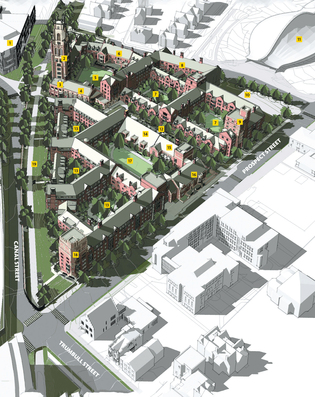 loading
loading
featuresDéjà vuYale’s newest residential colleges will be modeled on their forebears. Mark Alden Branch ’86 is executive editor of the Yale Alumni Magazine.  Robert A. M. Stern Architects, LLPView full image“Gothic is the signature language of Yale,” says Robert A. M. Stern ’65MArch. “If you want to show someone what Yale is about, you don’t stand them in front of Davenport College or Commons—you stand them in front of Harkness Tower.” For Stern, dean of the Yale School of Architecture, that language was the natural choice for the two new residential colleges now being built on Prospect Street. With his New York firm, Robert A. M. Stern Architects, Stern has spent the last several years immersed in a study of Yale’s campus, its residential colleges, and the neo-Gothic architecture of James Gamble Rogers, who designed Harkness Tower and 8 of the 12 existing colleges between 1917 and 1932. The resulting design is an unapologetic homage to Rogers’s work, a collage of images borrowed from the existing colleges and from other past architecture. “It’s not a literal copy of anything,” says Stern of the new colleges’ tallest tower, “but it’s the result of close study and interpretation.” That holds true for the design as a whole. Stern’s academic and historic approach has its detractors, and there will surely be vociferous critics of these new colleges—as vociferous as those who derided Rogers’s Yale work as “girder gothic” because it hid modern steel construction under its medieval cladding. But Stern argued, and the Yale administration agreed, that the new colleges were no place for aesthetic experimentation. Looking at the past colleges for inspiration is not just about style, though. The design borrows some of Rogers’s commonsense features, like the so-called moats that separate the colleges from the street, allowing for plantings that provide privacy to students on the ground floor. And like the older colleges, the new ones are arranged to admit southern light into the courtyards, keeping them sunny in winter and affording shade in the summer. “There is no significant feature of the existing colleges that doesn’t find its echo in the new colleges,” Stern says. And just as the original colleges held lessons, so did the extensive renovations of those colleges between 1998 and 2011, which added many new amenities. Masters and other users of the colleges told Stern’s design team what features worked best for them: from the renovation of Davenport and Pierson, for example, they learned that even rival colleges don’t mind sharing a fitness room. Planning those now-standard amenities—a black-box theater, music rooms, a dance studio, and more—for a new building is easier than squeezing them into former squash courts, as happened in the older colleges. Right now, the site of the colleges is mostly a hole in the ground, dominated by four huge construction cranes. But by the fall of 2017, the new colleges should be ready for occupancy. Stern hopes the students who live there will appreciate them as much as past and current students appreciate the existing ones. “I hope people will enjoy the colleges for the intricacy and dramatic play of scale,” he says. “You look at Branford from Library Walk, and it’s so cottagey. Then you go in through those three little courtyards into the big courtyard in Branford, and you have this tremendous juxtaposition of scale: gigantic tower and low buildings. Rogers did that deliberately to kind of wake you up and make you feel your environment. And I think students who go to Yale and live in one of these colleges day to day for three or four years sense those environments, and they take them with them for a lifetime.” Editor’s note: Two captions in this story originally stated that the west tower in North College will include bells for change-ringing, but the bells have been eliminated from the project as a cost-cutting measure.
|
|